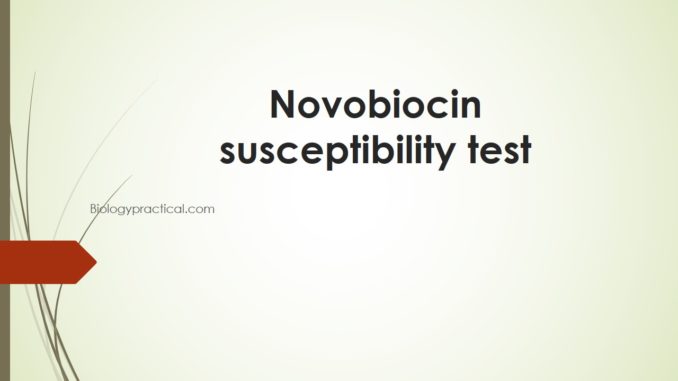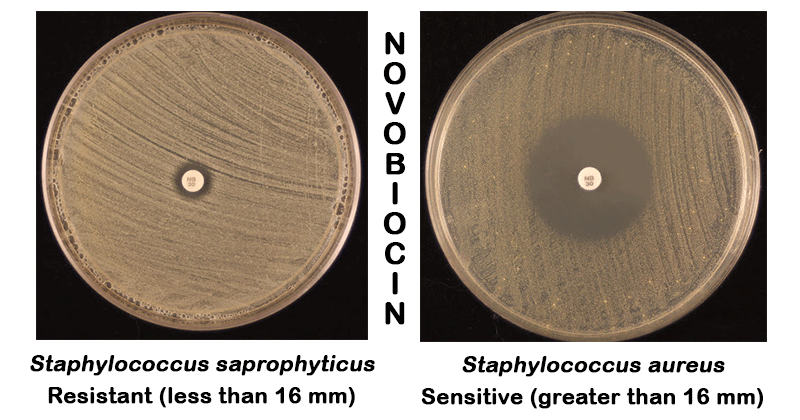
Principle:
- After E. coli, Staphylococcus saprophyticus is the second most causative organism for the Urinary tract infections (UTIs) in sexually active young women.
- Laboratory identification of Staphylococcus saprophyticus is performed on the basis of haemolysis, coagulase and resistance to novobiocin.
- Thus, after isolation of coagulase negative staphylococcus, laboratory should further identify the isolate and find out if the isolate is sensitive to novobiocin or not.
- Novobiocin is the antibiotic produced by the actinomycete Streptomyces nivens.
- Sensitivity to novobiocin is detected by placing a novobiocin impregnated paper disk on a agar plate seeded with the organism under identification.
- If the bacteria are sensitive to novobiocin, the formation of visible zone of inhibition is seen around the disk.
- The zone of inhibition represents the area where the growth of organism was inhibited by the antibiotic concentration.
- No zone of inhibition suggests the resistance of organism to the antibiotic.
Requirements:
- Isolated colonies of an aerobic, catalase positive, coagulase negative gram positive cocci.
- Mueller Hinton agar
- Blood agar/ Tryptic Soy agar
- Incubator
- Novobiocin disk
- Distilled water
- Sliding calipers/ metric ruler
Procedure of Novobiocin susceptibility test
- The test isolate taken is of 18-72 hours and in pure culture.
- Prepare a suspension of the test isolate in tryptic soy broth equal to a McFarland 0.5 standard or equivalent.
- Dip a sterile swab into the suspension and rotate it against the side of the tube above the fluid level in order to remove excess inoculum.
- Inoculate a blood agar or Mueller Hinton agar plate by streaking the expressed swab over the entire agar surface and repeat in 2 planes.
- Allow the agar surface to dry for exactly15 minutes before applying a Novobiocin Disk.
- Prepare a lawn of growth over the entire plate by use of sterile swab, swabbing over the entire plate in 3 directions and around the edge of the plate.
- Using alcohol-dipped and flamed forceps, aseptically apply a novobiocin antibiotic disc to the surface of each inoculated plate.
- Use sterile forceps to gently press the discs down to make sure that they adhere to the agar surface.
- Incubate plate aerobically for 18 to 24 hours at 35 to 37°C.
- Use sliding calipers or a metric ruler to measure the diameter of the zone of inhibition.
Results interpretation:
- Positive result:
- The positive test is indicated by the zone of inhibition greater than 16mm suggesting the sensitivity of the organism.
- Negative result:
- Negative test is indicated by the zone of inhibition less than 16mm which suggests the novobiocin resistance of the organism.

Limitations:
- Only isolated colonies of aerobic, catalase positive, coagulase negative gram positive cocci are to be tested.
- Biochemical, immunological tests are further recommended for the complete identification of the organism.
- Novobiocin disks can mislead the results if the test is performed for isolates other than urinary specimens.
